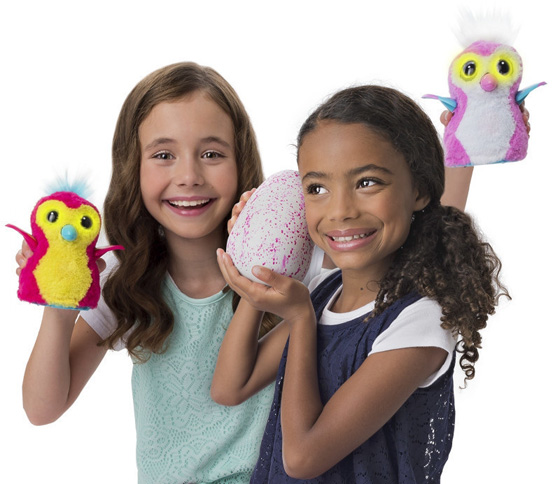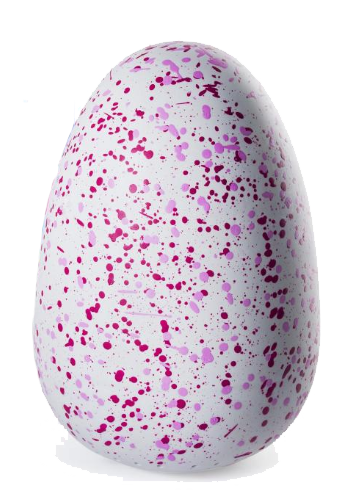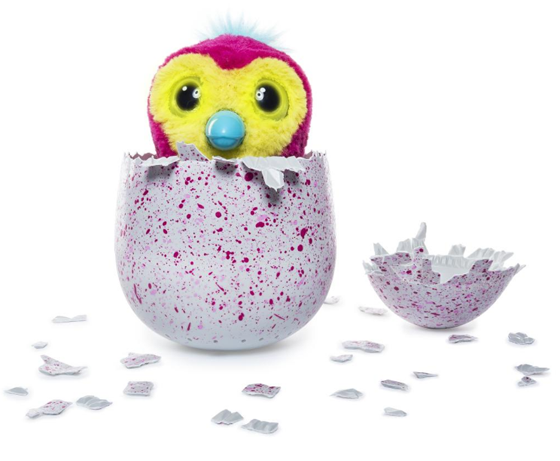
All year long, the toy industry was tight-lipped about what’s behind the hottest toy of the year—but now the secret has cracked.
Hatchimals, the newest line from Spin Master, is an interactive experience like we’ve never seen before. The Hatchimal is a magical creature that lives inside an egg—and that’s just the thing—the Hatchimal comes still in the egg. With the help of its owner and lots of love and care, the Hatchimal will peck its way right out of the egg and is ready to play. This is not a lie. This is real. This actually happens. ?
 The egg itself is made from durable material, so the only way to get the Hatchimal out is for it to get itself out. There are two species of Hatchimals, which are birds meshed with other creatures, Pengualas and Draggles. While kids can choose the species of their Hatchimal, there still is a surprise element because they don’t know what color creature is inside. Each egg can contains one of two color-themed Hatchimals: pink/teal eggs have a teal/yellow or teal/pink Penguala; pink eggs have a pink/white or yellow/magenta Penguala; blue/green eggs have a green or a blue Draggle; and blue/purple eggs have a purple/blue or purple/white Draggle.
The egg itself is made from durable material, so the only way to get the Hatchimal out is for it to get itself out. There are two species of Hatchimals, which are birds meshed with other creatures, Pengualas and Draggles. While kids can choose the species of their Hatchimal, there still is a surprise element because they don’t know what color creature is inside. Each egg can contains one of two color-themed Hatchimals: pink/teal eggs have a teal/yellow or teal/pink Penguala; pink eggs have a pink/white or yellow/magenta Penguala; blue/green eggs have a green or a blue Draggle; and blue/purple eggs have a purple/blue or purple/white Draggle.
Once kids pull the Hatchimal egg out of its packaging, the hatching process automatically activates. However, it won’t hatch on its own. Kids will have to nurture and care for their eggs in order for it to start hatching. If they don’t do this, then it won’t hatch. Pro tip: Don’t throw out the included instructions. They contain super helpful tips and tricks to identify how Hatchimals are feeling and how you can play with it!
The color of the Hatchimal’s eyes inside the egg and the sounds it makes will guide kids to know how it’s feeling. Dark blue eyes means it’s scared, so pat the bottom of the egg or make a loud sound to make it feel better. Once it feels better, its eyes may turn pink, which is a cuddly mood. If the egg is cold, its eyes will turn light blue and will make shivering sounds. Cuddle it some more make it warm again.
If kids move and tilt the egg around, it will make noises—but be careful! If its eyes turn green, it may have become too dizzy and kids must tilt the egg to help it sneeze or pat the bottom of the egg to help it cough and nurse it back to health. Make sure to attend to all of its needs, or else it will become angry or upset with red eyes.
When a Hatchimal is ready to hatch, its eyes will turn rainbow colored and this is the sign of a party. It will start pecking and spinning in circles to completely peck a hole around it. Every egg is different, and the hatching process can take anywhere from 10 to 40 minutes. Mine took about half an hour. Kids’ touch encourages the Hatchimal along the pecking process. Once it’s done, take the top off its head, firmly pull it out of its egg, and have another party as it starts singing “Hatchy Birthday!”
 That’s it, right? No. There’s so much more! Just like every newborn, Hatchimals are babies straight from the egg. Now, kids will get to raise their furry Hatchimal through three stages, from baby to toddler and then kid.
That’s it, right? No. There’s so much more! Just like every newborn, Hatchimals are babies straight from the egg. Now, kids will get to raise their furry Hatchimal through three stages, from baby to toddler and then kid.
In baby mode, kids will have to tend to their Hatchimal’s every need—and I mean every need—and it’s important to not egg-nore them. The Hatchimal will make cute sounds, flap its wings, and change directions here and there. All the fun is that you don’t know what it’s going to do or want next, and it knows exactly how you’re interacting with it. For example, if you are feeding it, and you make it stop eating before it’s done, then it will cry. I can’t even complain because of how relatable that is.
At one point, I felt as though it would never turn from a baby to a toddler. @Mom, is this how you felt with me?!
After 20 minutes of constant play, its eyes turned rainbow, and the Hatchy Birthday song started playing. I unlocked the next stage! In toddler mode, kids can start teaching their Hatchimal things, such as how to talk (it will repeat phrases in its own voice) and how to walk. They can also dance and play music, and when kids pat its head, it will make a drum beat. With more nurturing and play, the Hatchimal turned into a kid after about 25 minutes.
Strangely enough, you can just tell that the Hatchimal is older just by the noises it makes. In the last stage of development, kids can play four more games, in addition to interacting with it in all of the previous ways. The games include repeating patterns; “Hatchimal Says,” just like Simon Says; Psychic Hatchimal, where it will answer yes or no questions; and tag.
Hatchimals are a true unique experience that I have never seen before, from hatching itself to developing it from a baby to kid. (Parenting is hard.) The amount of play value in this toy is incredible, which results in a magical pal for life. There are additional species available exclusive to retailers, including the Owlicorn from Toys “R” Us, the Bearakeet from Target, and Burtle from Walmart.
Happy hatching!
